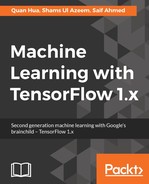So far, we mostly used TensorFlow for image processing, and to a lesser extent, for text-sequence processing. In this chapter, we will revisit the written word to find meaning in text. This is part of an area that is commonly termed Natural Language Processing (NLP). Some of the activities in this area include the following:
- Sentiment analysis—This extracts a general sentiment category from text without extracting the subject or action of the sentence
- Entity extraction—This extracts the subject, for example, person, place, and event, from a piece of text
- Keyword extraction—This extracts key terms from a piece of text
- Word-relation extraction—This extracts not only entities but also the associated action and parts of speech of each
This is just scratching the surface of NLP—there are other techniques, as well as a range of sophistication across each technique. Initially, this seems somewhat academic, but consider what just these four techniques can enable. Some examples include the following:
- Reading news and understanding the subject of the news (individual, company, location, and so on)
- Taking the preceding news and understanding the sentiment (happy, sad, angry, and so on)
- Parsing product reviews and understanding the user's sentiment toward the product (pleased, disappointed, and so on)
- Writing a bot to respond to user chat-box commands given in natural language
Much like the previous machine learning efforts we've explored, a decent bit of effort goes into setup. In this case, we'll spend some time writing scripts to actually grab text from sources of interest.
